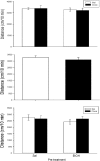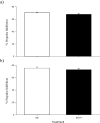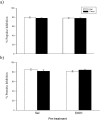Adolescent but not adult ethanol binge drinking modulates cocaine withdrawal symptoms in mice
- PMID: 28291777
- PMCID: PMC5349692
- DOI: 10.1371/journal.pone.0172956
Adolescent but not adult ethanol binge drinking modulates cocaine withdrawal symptoms in mice
Abstract
Background: Ethanol (EtOH) binge drinking is an increasingly common behavior among teenagers that induces long-lasting neurobehavioral alterations in adulthood. An early history of EtOH abuse during adolescence is highly correlated with cocaine addiction in adulthood. Abstinence of cocaine abuse can cause psychiatric symptoms, such as anxiety, psychosis, depression, and cognitive impairments. This study assessed the consequences of adolescent exposure to EtOH on the behavioral alterations promoted by cocaine withdrawal in adulthood.
Methods: We pretreated juvenile (34-47 days old) or adult (68-81 days old) mice with EtOH (1.25 g/kg) following a binge-drinking pattern. Then, after a three-week period without drug delivery, they were subjected to a chronic cocaine treatment in adulthood and tested under cocaine withdrawal by the ensuing paradigms: open field, elevated plus maze, prepulse inhibition, tail suspension test, and object recognition. Another set of mice were treated with the same EtOH binge-drinking procedure during adolescence and were tested immediately afterwards under the same behavioral paradigms.
Results: Adolescent EtOH pretreatment undermined the anxiogenic effects observed after cocaine abstinence, reduced prepulse inhibition, and increased immobility scores in the tail suspension test following cocaine withdrawal. Moreover, the memory deficits evoked by these substances when given separately were enhanced in cocaine-withdrawn mice exposed to EtOH during adolescence. EtOH binge drinking during adolescence also induced anxiety, depressive symptoms, and memory impairments when measured immediately afterwards. In contrast, neither EtOH nor cocaine alone or in combination altered any of these behaviors when given in adulthood.
Conclusions: EtOH binge drinking induces short- and long-term behavioral alterations and modulates cocaine withdrawal symptoms when given in adolescent mice.
Conflict of interest statement
Figures









Similar articles
-
Adolescent Exposure to the Synthetic Cannabinoid WIN 55212-2 Modifies Cocaine Withdrawal Symptoms in Adult Mice.Int J Mol Sci. 2017 Jun 21;18(6):1326. doi: 10.3390/ijms18061326. Int J Mol Sci. 2017. PMID: 28635664 Free PMC article.
-
Cognitive and neurobehavioral benefits of an enriched environment on young adult mice after chronic ethanol consumption during adolescence.Addict Biol. 2019 Sep;24(5):969-980. doi: 10.1111/adb.12667. Epub 2018 Aug 14. Addict Biol. 2019. PMID: 30106197
-
Repeated Cycles of Binge-Like Ethanol Exposure Induces Neurobehavioral Changes During Short- and Long-Term Withdrawal in Adolescent Female Rats.Oxid Med Cell Longev. 2022 Oct 25;2022:7207755. doi: 10.1155/2022/7207755. eCollection 2022. Oxid Med Cell Longev. 2022. PMID: 36329802 Free PMC article.
-
Oxidative Stress-Induced Brain Damage Triggered by Voluntary Ethanol Consumption during Adolescence: A Potential Target for Neuroprotection?Curr Pharm Des. 2019;25(45):4782-4790. doi: 10.2174/1381612825666191209121735. Curr Pharm Des. 2019. PMID: 31814553 Review.
-
The role of sex in the persistent effects of adolescent alcohol exposure on behavior and neurobiology in rodents.Int Rev Neurobiol. 2021;160:305-340. doi: 10.1016/bs.irn.2021.07.007. Epub 2021 Aug 11. Int Rev Neurobiol. 2021. PMID: 34696877 Free PMC article. Review.
Cited by
-
Adolescent Exposure to the Synthetic Cannabinoid WIN 55212-2 Modifies Cocaine Withdrawal Symptoms in Adult Mice.Int J Mol Sci. 2017 Jun 21;18(6):1326. doi: 10.3390/ijms18061326. Int J Mol Sci. 2017. PMID: 28635664 Free PMC article.
-
Differential Impact of Ad Libitum or Intermittent High-Fat Diets on Bingeing Ethanol-Mediated Behaviors.Nutrients. 2019 Sep 19;11(9):2253. doi: 10.3390/nu11092253. Nutrients. 2019. PMID: 31546853 Free PMC article.
-
Cannabidiol Modulates Behavioural and Gene Expression Alterations Induced by Spontaneous Cocaine Withdrawal.Neurotherapeutics. 2021 Jan;18(1):615-623. doi: 10.1007/s13311-020-00976-6. Epub 2020 Nov 23. Neurotherapeutics. 2021. PMID: 33230690 Free PMC article.
-
The Effect of Chronic Alcohol on Cognitive Decline: Do Variations in Methodology Impact Study Outcome? An Overview of Research From the Past 5 Years.Front Neurosci. 2022 Mar 10;16:836827. doi: 10.3389/fnins.2022.836827. eCollection 2022. Front Neurosci. 2022. PMID: 35360176 Free PMC article. Review.
-
The kynurenine pathway as a potential link between ethanol-induced behavioral alterations and neuroinflammation.Front Pharmacol. 2025 Jul 7;16:1628527. doi: 10.3389/fphar.2025.1628527. eCollection 2025. Front Pharmacol. 2025. PMID: 40693276 Free PMC article.
References
-
- EMCDDA-European Monitoring Centre for Drugs and Drug Addiction, European Drug Report: Trends and Developments, Publications Office of the European Union, Luxembourg, 2015, ISBN 978-92-9168-694-0.
-
- ESTUDES 2013 Informe de la encuesta estatal sobre el uso de drogas en estudiantes de enseñanzas secundarias. Delegación el gobierno para el Plan Nacional sobre Drogas. Ministerio de Sanidad y Política Social, Gobierno de España, Available: http://ww.pnsd.msc,es/Castegoria2/observa/pdf/PresentESTUDES2012_2013.pdf.
MeSH terms
Substances
LinkOut - more resources
Full Text Sources
Other Literature Sources
Medical

